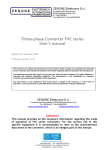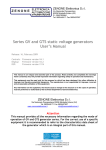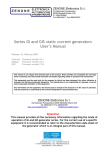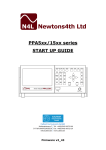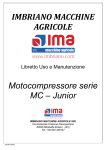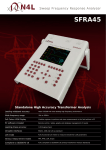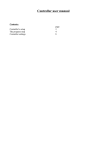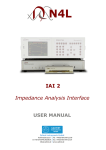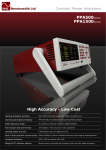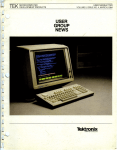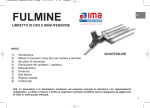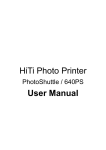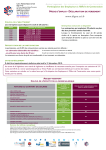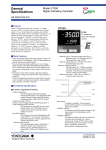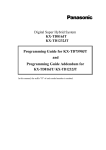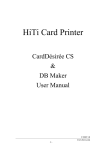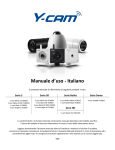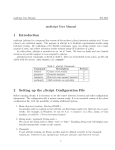Download Manuale GI new - Caltest Instruments
Transcript
ZENONE Elettronica S.r.l. Via Nazionale Pianopantano 83036 Mirabella Eclano (AV) P.I. 02407830641 Tel. 0825449171 Fax 0825407907 DC Power Supplies AL3000 series User’s manual Release xx, November 2011 Firmware version: DSP version: Vxx Vxx This manual is integrant and essential to the product. Read carefully and completely the instructions and the warnings herein, they will provide important information regarding safety of operation and maintenance. This equipment must be used only for the purpose for which has been designed. Any other utilization is improper and therefore potentially dangerous. The manufacturer is not responsible for possible damages caused by improper, incorrect and unreasonable utilization of this equipment. Any intervention on the equipment, that would cause a change in the structure or in the cycle of operation, must be performed or authorized by the technical department of Zenone Elettronica. ZENONE Elettronica S.r.l. Via Nazionale Pianopantano 83036 Mirabella Eclano (AV) Tel. 0825449171 Fax 0825407907 [email protected] www.zenoneelettronica.it Attention This manual provides all the necessary information regarding the mode of operation of AL3000 and AL3000R power supplies series. For the correct use of this specific equipment it is recommended to refer to the characteristics data sheet of the power supply, which is an integral part of this manual. Caltest Instruments GmbH Kohlmattstrasse 7 Tel: +49(0)7842-99722-00 D-77876 KAPPELRODECK Fax: +49(0)7842-99722-29 [email protected] www.caltest.de MUGL Page 2 of 41 rev. xx November 2011 (Regenerative)1 bidirectional Power Supply AL 3000R series The power supplies AL3000 and AL3000R series are fast AC/DC static converters with double conversion and IGBT technology under microprocessor control. They supply the load with voltage or current at the value that has been set regardless of the inpedance2) value and the mains fluctuations, they can also draw in energy from the load and put it on the mains net. They are particularly suited to users with high dynamic needs. The information about voltage and current supplied is shown by means of 7 segments displays. They can be controlled by external signals. They are equipped with RS485 serial interface for diagnostics and parameters setting. 1) R model 2) in current control mode Product presentation According to the output power, the equipment can be assembled in: table rack recessed rack metal cabinet Control interface commands and connections voltage setting command and visualization: current setting command and visualization: logical command for output-on: selection local/remote commands: line breaker: RS485 serial interface: mains supply: outputs: on front panel on front panel on front panel from serial interface on front panel on front panel from cable on the back side (rack version) on terminal blocks inside the cabinet (heavy duty cabinet version) on front panel jacks or bars (rack version) on terminal blocks inside the cabinet (metal cabinet version) MUGL Page 3 of 41 rev. xx November 2011 emergency input: auxiliary inputs/outputs on front panel on front panel Front panel Emergency Mains line breaker V Voltage setting A Current setting Output jacks Introduction Thank you for choosing our product. We invite you to read this manual thoroughly because here you can find the technical characteristics and all the necessary information for using this equipment correctly. The information contained in this document is subject to change without notice and it is expected to be updated exclusively for the product for which is provided. ZENONE ELETTRONICA is not liable for technical error, printing error or omissions that might be encountered in this manual; neither is responsible for accidental or consequential damages caused by the use of its product. This guide provides specific information related only to the mentioned products. No part of this manual may be reproduced in any form or by any means without our written consent. The software herein described is provided with end user license, unless otherwise specified. This technical document version voids and replaces all previous versions. The products cited in this document could be trademarks and/or registered mark of respective manufactures. MUGL Page 4 of 41 rev. xx November 2011 Summary 1. Preface ............................................................................................ 5 1.1 1.3 1.4 How to use and understand the instructions provided in this manual ............................ 5 Compliance declaration ...................................................................................... 7 Identification label ............................................................................................ 8 2.1 2.2 2.3 2.4 2.5 2.6 2.7 2.8 Working environment ......................................................................................... 9 Precautions ...................................................................................................... 9 Emergency circuit ............................................................................................ 10 Switching the equipment on ............................................................................... 10 Regeneration(only AL3000R models) .................................................................... 10 Regenerator error conditions ............................................................................. 11 Regenerator serial port .................................................................................... 12 Regenerator functional diagram (only AL3000R models) ........................................... 12 3.1 3.2 3.3 3.4 sensing.......................................................................................................... 13 Inputs ........................................................................................................... 14 Outputs ......................................................................................................... 14 Communication port ......................................................................................... 14 2. Preliminary operations ........................................................................ 9 3. Inputs / Auxiliary outputs ................................................................... 13 4. Power output................................................................................... 15 4.1 Command type selection ................................................................................... 15 4.2 Starting the output of power .............................................................................. 15 4.3 Setting the voltage and current values ................................................................. 15 4.4 Setting the simulated resistance ......................................................................... 16 4.5 Maximum power limitation ................................................................................ 16 4.5.1 Ramps up and down .................................................................................. 16 4.5.2 Separate control of the current limits (supply / absorption) .............................. 16 4.6 Visualization of values entered .......................................................................... 17 4.7 Visualization of measurements ........................................................................... 17 5. Maintenance instructions ................................................................... 17 6. External connections ......................................................................... 18 6.1 6.2 6.3 6.4 MAIN connections............................................................................................. 18 DB15 I/O connections ........................................................................................ 18 DB15 RS485 connection .................................................................................... 20 DB15 analog connections ................................................................................... 21 9.1 9.2 9.3 9.4 9.5 Control system block diagram ............................................................................ 24 Control system description ................................................................................ 25 Parameters definition and function ..................................................................... 26 Fine-tuning procedure for the control system ......................................................... 27 Technique for fine tuning the loops ..................................................................... 28 7. Error and faults signals ..................................................................... 22 8. Converter diagram............................................................................ 23 9. Control system................................................................................. 24 10. Software PWMutil .......................................................................... 31 11. AL Manager software ...................................................................... 33 10.1 10.2 11.1 12. Connection to a PC........................................................................................ 31 Connection through digital card ....................................................................... 32 Software installation .................................................................................... 33 Communication protocol VXX ........................................................... 34 MUGL Page 5 of 41 rev. xx November 2011 1. Preface 1.1 How to use and understand the instructions provided in this manual In this manual have been used conventional keys to simplify and standardize the utilization and the control of our generators. In this manual you can find also functions that might not be present on the equipment you have purchased; nevertheless proper information will tell you about eventual limitations. This solution has been chosen for clarity and to better evaluate the functional characteristics available on all our products. 1.2 Safety instructions The following notes or graphic symbols list a series of instructions essential for the correct use of the equipments. Such information could be found, in graphic form, also on the equipment or used in the manual to focus the attention on the specific issue. It is highly recommended to read such instructions carefully before equipment installation. Do not install the equipment in environments with temperatures different from those allowed Do not expose the equipment to direct sun light Do not pour any kind of liquids on the Equipment. In case of fire, use foam, CO2 or dry chemicals fire-extinguishers MUGL Page 6 of 41 rev. xx November 2011 Attention The lightning symbol within a triangle is a warning symbol that indicates the presence of “dangerous voltages” inside the equipment with risk of electric shock. ! The exclamation mark within a triangle is a caution symbol that indicates the presence of important additional information for the correct use of the equipment. The empty triangle it is a caution symbol that indicates a danger of equipment damage if improperly used. The text that follows this symbol gives information, recommendations or other particular instructions for the correct operation of the equipment. The text that follows this symbol gives information, recommendations or other particular instructions in order to avoid danger and/or injury to personnel. A proper disposal of the shipment packing is recommended. MUGL Page 7 of 41 rev. xx November 2011 1.3 Compliance declaration MANUFACTURER DECLARATION OF CONFORMITY The Zenone Elettronica Power Supplies : AL3000 and AL3000R are herewith confirmed to comply with the requirements set out in the Council Directive on the Approximation of the Law of Member States relating to: - Electromagnetic Compatibility, Directive 2004/108/EEC - EN 61000-6-1 - CEI EN 61000-6-1 (2° ed. 2007-10)Electromagnetic compatibility (EMC) - Part 6-1: Generic standards - Immunity for residential, commercial and light-industrial environments " - EN 61000-6-3 - CEI EN 61000-6-3 (2° ed. 2007-11) Electromagnetic compatibility (EMC) - Part 6-3: Generic standards - Emission standard for residential, commercial and light-industrial environments EN 61326-1 :2006 Electrical equipment for measurement, control and laboratory use - EMC requirements - Part 1: General requirements - Low Voltage Equipment Directive (2006/95/EEC) and EN61010-1 (“Safety of Electrical Measuring Apparatus”) Mirabella 01-03-2011 Zenone Eletrronica S.r.l. Luigi Zenone Copyright Acknowledgement: EN publications are subject to the Copyright of IEC. MUGL Page 8 of 41 rev. xx November 2011 1.4 Identification label Each equipment is identified by the following label. We invite you to consider the data shown in it as essential for product traceability, and to communicate them for eventual request for assistance. MUGL Page 9 of 41 rev. xx November 2011 2. Preliminary operations 2.1 Working environment The Power Supply is designed for indoor use. + 5 °C ° ! + 40 °C Place the device on a suitable support or on a plane surface for good stability. Be sure that proper ventilation is allowed and no objects obstruct the ventilation openings. 2.2 Precautions Operate the equipment at its rated mains voltage, on earthed outlet only. Fasten suitable cables or bars of adequate section on the output bolts, calculated on the bases of equipment functional characteristics. WARNING: Power connections can generate high temperature spots, that could cause burnings. WARNING: All standard power supplies are delivered with output FLOATING, not connected to any potential (unless otherwise specified); at the moment of installation MUST BE CONNECTED TO GND OR TO ANY OTHER POTENTIAL. Maximum allowed voltage on the output bolts, when not connected to earth, is 300VAC. If necessary connect eventual protection devices (differential relay, isolation control relay, etc.) ! WARNING : This equipment puts energy into the mains net, if power to the equipment is supplied from an external source (batteries, independent generator, etc.), make sure to have adequate protection elements complying with local actual regulations, and eventual authorizations from the energy supplier agency. MUGL Page 10 of 41 rev. xx November 2011 2.3 Emergency circuit The AL3000 series is equipped with an emergency circuit that provides to opening the main breaker The opening condition are: • Pressing the emergency button • Opening of doors • Main power failure • Opening external circuit The emergency circuit is always powered, even when the main breaker is off 2.4 Switching the equipment on Connect the power supply to the power mains, it is recommended to follow the instructions given on the equipment (or in the attached sheet) regarding voltage, frequency and earth connection, then turn on the power switch, that could be located on the back panel or by the cabinet side depending on the type of equipment. In some models the power-on command can be part of an external power supply frame. In some cases the integrated console, keyboard/display, can be connected to the cabinet by means of an external cable. At system power-on an self-diagnostic routine tests the most important equipment functionalities and detects eventual faults (the information are visible with the proper software). In case of failure or malfunctions, we must be informed in advance before sending the equipment to our laboratories. 2.5 Regeneration(only AL3000R models) The AL3000R power supply series are bidirectional devices, as a matter of fact they can either supply energy to the load or absorb energy from it; the energy is taken from or is put on the power mains. This function is accomplished through an extra converter called REGENERATOR. In fact it will adjust the DC voltage on an intermediate bus taking it or putting it back into the network, providing also to put in phase the absorption and the regeneration so to guaranty a PF >0.95 at Pn. According to the model, the regenerator block can be either internal to the equipment or external in a separate unit. The regenerator block, in normal mains network condition, does not need any setting or adjusting because it works autonomously controlling the BUS voltage, in some special cases it might be necessary to touch up some control parameters using the software PWMutil. The power that the equipment is capable to draw from the load is the same that is capable to supply. The regenerator has its own electronics with microprocessor that provides the energy management and the monitoring of all alarms and system parameters. MUGL Page 11 of 41 rev. xx November 2011 2.6 Regenerator error conditions Under error conditions, the regenerator stops the operation and signals the failure by display on the cards . The cause of the fault can be visualized by error code or means of the PWMutil program connecting it to the appropriate serial port on the regenerator. signal 1 2 3 4 5 6 7 8 9 A B C D E 0 Type error DC overvoltage DC undervoltage Over temperature IGBT Error (FAULT) Precharge error Current limitat NTC error CKS error AC overvoltage AC undervoltage HI frequency LOW frequency ZC missing Feedback error Slave T.OUT Remedy MUGL Page 12 of 41 rev. xx November 2011 2.7 Regenerator serial port The regenerator is equipped with standard RS485 serial port communication with rate fixed at 9600 DB9 Pinout RS485 B 1 A GND 2 5 2.8 Regenerator functional diagram (only AL3000R models) Line Input precharge DC out PWM Modulator Sync µP Control unit RS485 comm. serial MUGL Page 13 of 41 rev. xx November 2011 3. 3.1 Inputs / Auxiliary outputs sensing + output + sensing Main power V Internal measurement Sensing input Power output - sensing - output Sensing circuit diagram The sensing circuit has internally resistors that link the senses to the main output in order to prevent the AL3000 to go to its maximal voltage when the sense line is broken or accidentally removed. The resistors are sized that If the sense is broken or removed, the output voltage result: (Set output voltage X 1.1) circa If the sensing is reversed the AL3000 will not started and can break the sense circuit. MUGL Page 14 of 41 rev. xx November 2011 3.2 Inputs The AL 3000 power supplies are equipped with some inputs for the remote control. function Emergency on – off Voltage command Current command 3.3 Description NC contact with no voltage, its opening causes the immediate disengagement of the line breaker disconnecting the equipment from the mains NO contact with no voltage, allows to start the power supply from a remote command Analog input 0 ÷ 10V, remote command for the output voltage 0 ÷ 100% Analog input 0 ÷ 10V, remote command for the output current 0 ÷ 100% Outputs The AL 3000 power supplies are equipped with some outputs for remote signaling. function Run/stop Alarm description PNP digital output, signaling for output on/off Max 30V 0,5A PNP digital output, fault signaling Max 30V 0,5A 3.4 Communication port The power supply is equipped with a RS484 communication port which allows to connect a PC for some parameters setting and for the alarm register reading. The Baud Rate is the transfer speed and is set at 9600. MUGL Page 15 of 41 rev. xx November 2011 4. Power output 4.1 Command type selection The selection of the command type: • Front panel • analog or digital inputs • serial port can be done via serial link by means of “AL Manager” software. 4.2 Starting the output of power After the preliminary operations, connecting the equipment to the mains and to an eventual load, have been done it’s possible to turn on the power supply acting on the main switch. Note: the main switch will not activate if the emergency circuit is open or the emergency push-button is pressed. Once the equipment is turned on it’s possible to start the output of power in following ways: • With local command; acting on the on-off push-button. • With remote command; activating the proper input. • With command from serial port; entering the appropriate string. Under these conditions the power supply will take immediately the voltage and current values set. 4.3 Setting the voltage and current values The setting of voltage and current output can be done: • With local command; by means of the potentiometers on the front panel • With remote command; by means of analog signal 0 ÷ 10V • With command from serial port; by means of appropriate strings Note: some particular settings are possible only by means of command from serial port MUGL Page 16 of 41 rev. xx November 2011 4.4 Setting the simulated resistance The power supply can simulate a resistance in the output such that given a set voltage V: The output voltage is dynamically reduced by the value R (set) x I (circulating) in case of power output, is dynamically increased by the value R (set) x I (circulating) in case of absorption. The resistance setting is expressed in OHM with respect to the maximum value and has a 1mOHM resolution. It can be done through the analog input (if selected) or through a serial string. If resistance is selected on analog input, is possible to set the maximum value corresponding at 10V by software “GESMD” Note: with simulated resistance and some types of reactive loads instabilities might be triggered. 4.5 Maximum power limitation The power supply can work with constant power operation. To use this function first adjust voltage and current limits within which you want to work, then set the value of maximum power output. In these conditions when the load will require more power than that set, the voltage will be automatically decreased so that the P (out) ≤ P (set). In the case of regeneration the voltage is increased. The setting of power is expressed in W with respect to the value of the specification sheet and has a resolution of 1W. It can be done through analog input (if selected) or through serial string. 4.5.1 Ramps up and down Ramps up and down allow a "sweet" start of the output voltage avoiding overshoot. Ramps can be set at “0” or from 100mS up to 10S. Ramps have effect only during the transition OFF-ON. The setting of ramps can be done through serial interface. 4.5.2 Separate control of the current limits (supply / absorption) You can independently set the maximum limits of positive and negative current. In this way the power supply will follow the current limitation set by the potentiometer or other input up to the maximum limit set for this polarity, for any other value over the limit the current will be cut to the limit. This function is used to set profiles of current asymmetrical between supply and absorption. The two parameters are settable by serial link. MUGL Page 17 of 41 rev. xx November 2011 4.6 Visualization of values entered In stand-by it’s possible to visualize on the displays the voltage and current values simply pressing the “F1” push-button “F1” pressed = visualization of voltage and current entered “F1” released = off 4.7 Visualization of measurements While the output is on the power supply shows on the displays the voltage and current outputs. Pressing “F1” it’s possible to visualize voltage and current setting. 5. • • • Maintenance instructions Check periodically the air vents, clean them or change the filter; Check the fans efficiency. Check periodically the bolts of the connections between the power outputs and the external circuit under test. MUGL Page 18 of 41 rev. xx November 2011 6. External connections 6.1 MAIN connections Output DB15 Line input EARTH bar 6.2 DB15 I/O connections DB15 Pin Out I/O section Vout 24Vcc max 100mA 9 in1 1 in2 2 11 3 12 0V +24V 10 Out 1 Out 2 4 24V (20-30V) Max current sink from each input: 4mA@24Vdc Max current for each output: 500mA MUGL Page 19 of 41 rev. xx November 2011 I/O section The I/O section of the interface connector is made of: • 2 Inputs “PNP” type at 24V (Pin 1 and 2) • 2 outputs “PNP” type at 24V (Pin 11 and 12) • 1 24V supply output limited at 100 mA max • 2 Pins assigned for a 24V supply (4=GND e 10=VCC). MUGL Page 20 of 41 rev. xx November 2011 The inputs have the following function: • Input 1: Allows to START the output supply • Input 2: Not used • Input “Emergency”: normally closed to the common of 24V. When opened causes the disengagement of the line breaker. The outputs have the following function: • Output 1: Active when the power output is on. • Output 2: Active in case of fault. 6.3 DB15 RS485 connection 5V DB15 Pin-out (RS485 section) 1K A 5 GND 13 B 6 1K GND RS485 section The RS485 section of the interface connector is made up of pin “A” and “B” of the RS485 interface and of a Ground pin. For a proper functioning of the serial communication it’s suggested to insert in a point of the line two resistance of 1K ohm connected as in the diagram. MUGL Page 21 of 41 rev. xx November 2011 6.4 DB15 analog connections DB15 Pin-out (Analog section) GND 6 AIN1_P AIN1_N 7 14 8 15 AIN2_N AIN2_P ANALOG section The Analog section of the interface connector is made of pin: • AIN1_P and AIN1_N of the Analog input 1 (Pin 14 and 7) • AIN2_P and AIN2_N of the Analog input 2 (Pin 15 and 8) • Reference ground GND (Pin 6) They are two balanced inputs that can take a maximum voltage of +/- 10V with respect to GND. Their function, when enabled by appropriate command via RS485, is to set the Voltage (Input 1) and the Current (Input 2). MUGL Page 22 of 41 rev. xx November 2011 7. Error and faults signals The converters are equipped with self-diagnosis routine, in case of anomalous event they stop the power output and show an error message. Signal Cause DSP X FAIL Communication error between the central processor and the DSP shown by nr. X Generic error FAIL XX signal Type error 1 DC overvoltage 2 DC undervoltage 3 Over temperature 4 5 6 7 8 9 A B C D E 0 IGBT Error (FAULT) Precharge error Current limitat NTC error CKS error Remedy Shut off and turn on the equipment; if the error remains contact the assistance See the display on cards or connect a PC to the equipment and by means of the software “PWMutil” check the table below Remedy Check the mains voltage, the presence of all three phases and that the regenerator works properly. Check the mains voltage, the presence of all three phases and that the regenerator works properly. Shut off the equipment and wait a few minutes. If the phenomenon repeats check the air vents and the operation of the fans. Contact the assistance Check the precharge relay. Check the load or the parameters settings. Contact the assistance. Feedback error Slave T.OUT If the fault remains, contact the assistance. MUGL Page 23 of 41 rev. xx November 2011 8. Converter diagram Output BUS DC Input PWM Modulator µP Serial Command I/O Control Unit Functional diagram Power supply/load section MUGL Page 24 of 41 rev. xx November 2011 9.. Control system The power supply is equipped with a sophisticated digital control system, which has to keep the voltage and/or the current output constant regardless of load change and mains variations. The regulation is based on two PID algorithms in sequence and named: “Internal” with feedback from internal current, “External” with feedback from the output voltage. The following figure shows the principle of operation 9.1 Control system block diagram Output current Power limitation Current regulation External Loop F.F. Voltage reference REF1 + REF + - REF2 PWM - Ramp Output voltage Internal current Internal Loop The control loops are pre-adjusted in production to achieve a good compromise between speed and stability for most loads, in some cases it is necessary to modify some parameters for the following reasons: • • • Oscillations due to a load too reactive To enhance the generator dynamic performance To adapt the generator to the load MUGL Page 25 of 41 rev. xx November 2011 9.2 Control system description The control system is based on two PID loops in sequence, named “Internal” and “External”. The internal loop is the fastest and regulates the current in the load. It takes input the external loop reference properly adapted by the current regulation. The external loop regulates the output voltage, reacts more slowly and provides the value of current to the internal loop. It takes at the input the main reference and the feedback comes from the output voltage of the power supply. External loop Integral limitation + 1 REF + + + 1 Output voltage Derivative limitation REF1 to internal loop MUGL Page 26 of 41 rev. xx November 2011 Internal loop Offset F.F. Current limiter Integral limitation + + 1 + REF1 (from external loop) Amplitude REF2 + + - To modulator 1 Internal current Derivative limitation From voltage control 9.3 Parameters definition and function range 0 ÷ 10000 It’s the proportional gain of the regulation loop (it causes the output to change according to the input error) Kp: Ti: range dt ÷ 32000µS; 0 = integral disabled It’s the integration time of the regulation loop in microseconds, can be applied directly or multiplied by the parameter Kp (causes the output to change with a speed proportional to the error, sets the regulation point canceling out the offset). Td: range dt ÷ 32000µS; 0 = derivative disabled It’s the derivative time of the regulation loop in microseconds, can be applied directly or multiplied by the parameter Kp (causes the output to change proportionally to the rate of change of the input, reduces the system response time). dt machine cycle time not changeable. Positive integral limitation: range 0 ÷ 100% It’s the maximum value the variable integral can take Negative integral limitation: range 0 ÷ 100% It’s the minimum value the variable integral can take MUGL Page 27 of 41 rev. xx November 2011 Positive derivative limitation: range 0 ÷ 100% It’s the maximum value the variable derivative can take Negative derivative limitation: range 0 ÷ 100% It’s the minimum value the variable derivative can take F.F. Feed forward range 0 ÷ 20 It’s the anticipation value on the current output, is used to speed the voltage recovery during the load variations. 9.4 Fine-tuning procedure for the control system Note: To change the control parameters it’s necessary to have a PC connected to the serial port of the console and the software program “PWMutil”. (Look at paragraph “PWMutil software”) The following paragraph provides only a guide for the fine tuning of the PID regulation loops since in many cases a unique rule it’s not applicable and regulations are made on the bases of personal experience. Note: Eventual parameters modifications must be done by specialized personnel only because these modifications could cause malfunctions and/or generator damages. Note: Before making any change to the regulation parameters it’s advisable to take note of the existing parameters so to restore the initial setup. In most cases, in particular when the equipment must be adapted to the load, it’s sufficient to make slight changes to some parameters following simple rules: In case of sever capacitive load, lower the Kp coefficients and increase the integration time Ti. In case of sever inductive load, increase the Kp coefficients and lower the integration time Ti. MUGL Page 28 of 41 rev. xx November 2011 9.5 Technique for fine tuning the loops The fine tuning of the PID loops must be done in two phases, first the internal one and then the external. In order to fine tune and verify the dynamic performances of the generator, it’s better to set the references with an external generator connected to the proper input, using a square waveform with the following parameters: Frequency > 0 < 50Hz Amplitude 0 ÷ V <5V or have an external dynamic load Under these conditions freeze the external loop and adjust the parameters Kp, Ti and Td of the internal loop to get maximum performance. Once the internal loop has been fine tuned, the parameters Kp, Ti and Td of the external loop can be adjusted so to optimize the global performance. Ideal system response to a step function MUGL Page 29 of 41 rev. xx November 2011 Step function response varying Kp with Ti constant Step function response varying Ti with Kp constant MUGL Page 30 of 41 rev. xx November 2011 Step function response with Kp too high Step function response with Kp and Ti too small MUGL Page 31 of 41 rev. xx November 2011 10. Software PWMutil The “PWMutil” software is compatible with WINDOWS XP systems and allows to set up some important parameters of the power supply; it must be installed on a suitable PC and executed. Such software is designed to set up the parameters of different equipment types we produce, therefore it’s possible that are displayed some parameters that have no function for this specific power supply. 10.1 Connection to a PC The equipment must be connected to the PC trough the serial port of the console by means of the specific cable. After the connection has been done and the program PWMutil is executed, the following mask will appear: By means of the menu “Set” it’s possible to select the parameters for the serial link: PC port and baud-rate. In this case the baud-rate must be 9600 Alarm Box Output parameters 1 Set parameters 2 MUGL Page 32 of 41 rev. xx November 2011 The PWMutil can work in two ways: • directly on modulation board (ZEL1004) • through digital card (ZEL0901) 10.2 Connection through digital card Enter the following parameters in position “2”: • “Device Address”: serial address of the power supply • “DSP Address”: serial address of the power module (if more power modules are present: 1 for module 1, 2 for module 2, etc..; in case of one module only, enter 1) Once the parameters have been set-up as shown above, push the button “Connect” to start the connection. In this situation the mask will appear as shown above and it’s possible: • display the machine state with the readings of Output voltage, Output current, AC mains voltage, DC BUS voltage, temperature of heat sink and the state of the alarms. With the RESET button it’s possible to reset some stored alarms. • In quadrant 1 appear the box “Enabe control panel”, if checked is possible to set parameter in the appropriate boxes. This if the power supply is in off state (this function excludes all other controls front panel, analog input, ecc) • By means of the button “PIDs parameter” to step into the next mask where the PWM parameters are shown and could eventually be changed. 1 MUGL Page 33 of 41 rev. xx November 2011 The sampling timing “dt” is shown at point “1”. In order to change any parameter just overwrite it and press ENTER on the keyboard. The button “REFRESH” provides an over-reading of the parameters stored in the memory module. ! Warning: in case of more power modules, the regulation parameters must be the same for each module. 11. AL Manager software The “AL Manager” software allows the total control of the power supplies AL2000M and AL2000BX series. AL Manager software can handle up to 32 power supplies AL2000 series. 11.1 Software installation The “AL Manager” software is compatible with Windows XP and is supplied in a compressed package. For the installation just click over the proper icon and accept the license agreement terms. The “AL Manager” program is supplied with free license for the ZENONE ELETTRONICA equipments users and its disclosure it’s forbidden. Note: ZENONE ELETTRONICA disclaims any liability for incompatibilities or conflicts with other software and operating systems. MUGL Page 34 of 41 rev. xx November 2011 12. Communication protocol VXX Communication protocol It’s possible to communicate with the device (send commands and get replies) by means of the RS485 serial interface, according to a half-duplex communication protocol. The settings of the communication port is: Device address: Baud-rate: Number of bits: Stop bit: Parity: from 1 to 32 9600 b/s 8 1 None (assigned with appropriate software) Each command and each reply are preceded by a start (STX) and the address (IND) of the device we intend to communicate with, followed by a stop (ETX) and a checksum (CKSUM) for the data correctness verification. STX IND Command or reply ETX CKSUM STX IND = = ETX CKSUM = = Start character, Hexadecimal value 0x02 Device address, added to the hexadecimal value 0x80 (ex. Address 1 = character 0x81) Stop character, Hexadecimal value 0x03 Control checksum, it’s a character sum of all characters of the command, Inclusive of STX and ETX characters, module 256. Each command that carries a parameter receives a reply with a result character (ESI) that can have the following values: “0” = Command executed. “1” = Command not executed. MUGL Page 35 of 41 rev. xx November 2011 General information commands and device options Device serial number request Command 0x10 "S" Reply 0x10 "S" Serial number Device firmware version request Command 0x10 "F" Reply 0x10 "F" Firmware version Device name request Command 0x10 "N" Reply 0x10 "N" Device name Request and setting device setup mode Command 0x10 "M" Command 0x11 "M" Setup mode setting Reply 0x10 "M" Setup mode Reply 0x11 "M" ESI "0" Setup and start from panel "1" "2" "3" “4” Setup and external start Note: In case of remote mode (look at appropriate command 0x15 “M”), this command has effect only for the start. MUGL Page 36 of 41 rev. xx November 2011 Commands for test main setup Request and setting voltage value Command 0x12 "M" Reply if IDX ok 0x12 "M" IDX IDX UMIS Voltage value * Reply if IDX not ok 0x12 "M" ESI Command 0x13 "M" IDX Reply 0x13 "M" ESI IDX UMIS Voltage value * = 0x81 (Fixed value) UMIS = “1” (Fixed value) * For the allowed ranges refer to equipment specifications Request and setting current value Command 0x12 "E" Reply if DX OK 0x12 "E" IDX IDX UMIS Current value * Reply if IDX not OK ESI 0x12 "E" Command 0x13 "E" IDX UMIS Current value * IDX = 0x81 (Fixed value) UMIS = “1” (fixed value) Ampere * For the allowed ranges refer to equipment specifications Reply 0x13 "E" ESI MUGL Page 37 of 41 rev. xx November 2011 Request and setting maximum power value Command 0x12 "X2" Command 0x13 "X2" Power Reply 0x12 “X2” Power 0x13 Reply ESI Power is in Watt from: 0 to f.s. Request and setting internal resistance Command 0x12 "X1" Reply 0x12 "X1" Resistor Command 0x13 "X1" Resistor Reply 0x13 ESI Resistor is in Ohm from: 0.001 to 1000 MUGL Page 38 of 41 rev. xx November 2011 Request and setting reference sources. Command 0x20 "C" Reply RIF 0x20 "C" RIF SRC Reply if RIF not OK 0x20 "C" ESI Command 0x21 "C" RIF Reply 0x21 "C" ESI RIF2 SRC Reference values and associated source RIF “0” “1” “2” “3” “4” “5” Voltage Current Source of START Not used RESISTANCE reference POWER LIMITATION reference “0” SRC “1” “2” Pot. 1 Pot. 2 Panel Pot. 2 Fixed 0 ohm Fixed MAX Input AN1 Input AN2 Input IN1 Input AN2 Input IN1 Input AN2 From serial From serial From serial From serial From serial From serial Nota: This command ESI can take also value “2”. In this case means that SRC you want to use is already used by the reference RIF2. Request end sending RAMP timing Command 0x12 "T" Reply if IDX OK IDX UMIS RAMP timing (ms) 0x12 "T" IDX Reply if IDX not OK 0x12 "T" ESI Command 0x13 "T" IDX UMIS RAMP timing (milliseconds) IDX = 0x81 (Fixed value) UMIS = “0” (Fixed value) Reply 0x13 "T" ESI MUGL Page 39 of 41 rev. xx November 2011 Request and sending Ramp mode Command 0x12 "R" Reply if IDX OK 0x12 "R" IDX Mode IDX Reply if IDX not OK 0x12 "R" ESI Command 0x13 "R" IDX IDX Reply 0x13 "R" Mode = 0x81 (Valore fisso) Mode “0” No ramp “1” Linear ramp Commands for reading the actual values Reading the actual state Command 0x14 “E” Reply 0x14 Test state "0" Halt "1" Running “2” “3” “4” “5” “6” Fail (failure or malfunction) “7” “A” “E” State or test result ESI MUGL Page 40 of 41 rev. xx November 2011 Reading the actual voltage Command 0x14 “M” FA FA Reply 0x14 “M” UMIS Actual value Necessary in the three-phases devices. Select the phase to read (“1”,”2”,”3”), if omitted it means “1” UMIS “0” “1” Millivolt Volt Reading the actual current Command 0x1 “S” 4 FA UMIS “0” “1” FA Reply 0x14 “S” UMIS Actual value Necessary in the three-phases devices. Select the phase to read (“1”,”2”,”3”), if omitted it means “1” Millivolt Volt Milliampere Ampere Reading the remote connection state Command 0x14 "L" Connection state “L” Not ACTIVE “R” Active Reply 0x14 "L" Connection state MUGL Page 41 of 41 rev. xx November 2011 Test Start and Stop commands Enables remote mode Command 0x15 "M" Mode Reply 0x15 "M" ESI Remote mode Not active “L” Active “R” In “Remote” mode the output values are defined via SERIAL link. The start can be given from SERIAL link or from PANEL/EXTERNAL according to the appropriate command (0x11 “M”). Supply start Command 0x15 "R" Reply 0x15 "R" ESI Note: It’s possible to start the supply only if in remote mode and start from selected PANEL/EXTERNAL. The positive result of the command means that it was accepted but, in order to be sure the start has taken place, it’s necessary to read the device state (Command 14E). Supply stop Reply 0x15 "S" Command 0x15 "S" ESI Note: It’s possible to stop the supply only if in remote mode and stop from selected PANEL/EXTERNAL. The positive result of the command means that it was accepted but, in order to be sure the stop has taken place, it’s necessary to read the device state (Command 14E). Address assignment Command 0x15 "A" IND Reply 0x15 "A" ESI









































